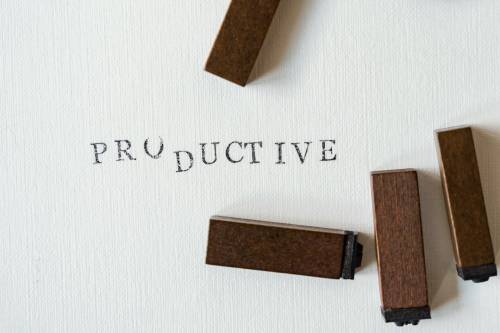

It’s something we’ve all experienced. Our to-do lists feel a mile long. Blinking cursors mockingly stare back at us, and, there’s the feeling that there aren’t enough hours in a day. At the same time, we’re being bombarded with productivity advice about prioritizing to-do lists, timeboxing, and the Pomodoro Technique. In many cases, they work — but at the same time, they are often the same tired tips.
Nevertheless, what if you’re looking for something fresh that will awaken your productivity? Well, you can. It’s time to break away from the mundane and explore unconventional strategies to unleash your inner powerhouse.
1. Tap into the power of the “Reverse” To-Do List.”
In fairness, traditional to-do lists are a great way to stay organized, and everyone should use them if you want the impetus and power to do big things in your life. On occasion, however, your to-do list can lead to stress and overwhelm. This is where the “reverse” to-do list comes into play.
Reverse to-do lists are exactly what they sound like: rather than listing the tasks you need to accomplish, you begin by listing your achievements. You can use this to boost your mood and motivation.
As a first step, write down everything you accomplished during the day. With this simple shift, you flip the script from looming tasks to a record of your daily accomplishments. Seeing your achievements in black and white fosters a sense of accomplishment and motivates you to keep going.
2. Have a “Nappuccino.”
Are you suffering from the infamous 3 p.m. slump? You might be surprised by this science-backed solution: The Nappuccino Technique.
If you want to double your productivity, take a 20-minute power nap and add caffeine. This combo helps you get over midday droop like a boss by improving sharpness and concentration.
In addition, Daniel Pink says that naps boost mental and physical health and improve cognitive performance. Specifically, napping is like a Zamboni for our brains. They aim to smooth out the nicks, scuffs, and scratches we leave on our mental ice from a typical day.
However, don’t forget to set an alarm. If you nap for too long, your sleep cycle can be disrupted.
3. Aligning your chronotype.
Aligning your sleep schedule with your biological preferences is called chronotype alignment. Depending on a person’s chronotype, they can vary from being extremely morning to being extremely evening.
Dr. Richard Coleman, a chronobiologist with extensive experience developing shift and night work schedules, maintains that only about 10 percent of the population are extreme owls or extreme larks/early birds. Other sources report that night owls and early birds make up 20% of the population, while intermediates account for 80%.
How can your chronotype be determined? Often, this is based on genetics, environment, age, sex, and the amount of light you receive each day.
If you need to reset your chronotype, it’s also important to stick to a routine. Every day, including weekends, you should go to bed and wake up at the same time. You can observe when your body naturally starts to feel sleepy and when it feels good to wake up.
4. Embrace your inner child with a “Playful Break.”
Take a break from screens and rediscover unstructured play. Doodling, building Lego masterpieces, and even blowing bubbles are some examples. Despite their apparent childishness, these activities stimulate creativity and relaxation.
Moreover, after a mental palate cleanser, they allow you to return to work with a fresh perspective.
5. The “Don’t Break the Chain” Method.”
In the “Don’t Break the Chain” Method, you mark an “x” on your calendar each day you accomplish a goal. As a result, a chain of ‘x’s’ can extend for days, weeks, or even months. Since Jerry Seinfeld popularized the technique, it is also known as “Jerry Seinfeld’s secret to productivity.”
Why is this so effective? You need to stay on top of things to stay on track and accountable. Seeing the chain of marked days can also motivate you to keep the streak going. As a streak of accomplishments continues, it becomes increasingly rewarding, breaking it harder.
6. Start each day with a toad.
You’re probably familiar with “eating a frog” in the morning. In case you’re not, here’s a brief summary
In his famous quote, Mark Twain said that you should only eat live frogs in the morning, or you will suffer worse effects all day. People now use this strategy when trying to prioritize and get things done.
But frogs can be overwhelming. So, why not start with something smaller, like a toad?
Nicolas Chamfort wrote, “Swallow a toad in the morning if you want to encounter nothing more disgusting the rest of the day.” A good “toad” might be anything you’ve been avoiding, whether filling out a lengthy application form or sending a stressful email.
7. Create a sensory-friendly workspace.
External stimuli such as smells, visuals, or sounds are minimized or controlled in sensory-friendly offices.
While sensory-friendly modifications may seem insignificant to some, they can make a major difference in an employee’s job satisfaction, productivity, and comfort. It is especially helpful for those with sensory processing disorders, such as ADHD, generalized anxiety disorder, autism, and many others. It is estimated that one in six people have difficulties with sensory processing.
The following are some key aspects to consider:
Sight.
- Lighting. Cut back on harsh overhead fluorescent lights. Instead, offer lamps with a dimmer that can be adjusted to meet the needs of each individual. Also, let in as much natural light as possible with unobstructed windows.
- Visual clutter. Clutter should be kept to a minimum on desks and in common areas. Also, for your walls and furniture, choose neutral and calming colors.
Sound
- Quiet spaces. For focused work or relaxation, provide designated quiet rooms or pods. It is a good idea to consider soundproofing materials for walls and partitions.
- Noise reduction. Encourage the use of headphones to control noise individually. In open areas, place rugs and panels that absorb sound.
Smell
- Fragrance-free. Avoid using strongly scented products such as perfumes, air fresheners, and lotions.
Touch
- Seating options. Provide different seating options, such as ergonomic chairs and stability balls.
- Temperature control. If possible, maintain a comfortable temperature range.
Additional Considerations
- Flexible work arrangements. Consider hybrid or remote work options whenever possible to reduce overall sensory overload in the office.
- Open communication. It is important to encourage employees to communicate their sensory needs and preferences.
When you incorporate these elements, all employees will be able to focus, feel well, and be more productive.
8. The “Declutter Your Brain” technique.
Feeling overwhelmed by the number of ideas and tasks swirling around in your head? If so, grab a pen and paper and jot down your thoughts. Just make sure that everything should be written down, from grocery lists to project ideas.
By externalizing your mental clutter, you can see things more clearly, prioritize tasks, and free up mental space to focus.
9. Take more mindful micro-breaks.
It’s time to break free from the “always on” mentality. To start, schedule short, deliberate breaks throughout the day. However, make sure you don’t scroll through social media mindlessly. Consider taking a walk outside, stretching, or practicing mindful breathing instead.
By taking these micro-breaks, you can refocus and become more productive.
10. Tactile feedback for time management.
In addition to improving time management awareness, tactile feedback can improve task shifts and time distribution. An example of tactile feedback is using surface textures, buttons, and other tangible elements to create a physical touch experience.
Tactile feedback can be used for time management in the following ways:
- Analog tools. You can use a traditional planner, wall calendar, or simple notebook to keep track of your tasks.
- Large calendar whiteboard. Organize sticky notes according to projects and dates by using colored sticky notes.
There is some evidence that tactile feedback can improve performance related to an event.
11. Deprioritize tasks that are causing you stress without any reward.
To be productive, you have to prioritize. However, prioritization has a dark side, as RescueTime’s Jory MacKay points out.
Despite knowing you should stop working on something once it becomes a priority — it’s impossible to stop.
Deprioritizing, however, involves actively removing items from your list.
Deprioritizing means evaluating the many tasks you have planned, started working on, or even put blood, sweat, and tears into and saying, “This isn’t a priority for me anymore,” Jory explains.
In short, by working on the right things, we can remain motivated even during the toughest of times. However, how do you find and deprioritize tasks that are no longer worthy of your time?
To get you started, here are a few suggestions:
- Limit the amount of time you spend working on projects and tasks. Reassess your priorities at specific intervals through friction.
- Create a ‘not to do’ list. Is there anything you are sure you don’t want to do right now (or ever)?
- Reassess your priorities every week. Structured processes can help you determine, “Is this really important to me?”
- Focus only on the most important elements of an important task or project. It’s important to remember that prioritizing doesn’t have to be one-sided.
- Consult your team or boss about what’s important to them. If you’re feeling stuck, ask for help from a colleague, friend, or family member.
12. Reward yourself — the right way.
You can motivate yourself with rewards, but avoid sugary treats and mindless scrolling. Instead, use intrinsic rewards to reinforce positive behaviors. Have you completed a task? Listen to your favorite song, go for a walk outside, or eat a healthy snack.
In the long run, these small rewards will keep you engaged and motivated.
Final Words of Advice
Don’t be afraid to experiment and customize the hacks listed above. Depending on the individual, what works for one person may not work for another. To unlock your hidden productivity potential, you must find unconventional strategies that resonate with you.
[Related: Technology’s Role in Productivity and Five Ways to Finding The Right Tools]
FAQs
What are productivity hacks?
You can use productivity hacks to improve your productivity and get more done in less time by using shortcuts, methods, and tricks. You can find hacks for every work style and personality out there.
Do productivity hacks really work?
Although there is no magic bullet for productivity, many productivity hacks can be very effective. To find out which hacks work for you, you need to find ones that complement your tendencies.
How do I know which hacks will work for me?
A variety of productivity hacks are available, but the best ones suit your work style and preferences. Find out what helps you stay focused and accomplish your goals by experimenting with different techniques.
How can I build good productivity habits?
Good productivity habits can be built by following these tips:
- Start small and be consistent. Try not to make too many changes at once. Consider implementing one or two hacks and sticking with them for a while.
- Find what works for you. Find out what hacks help you be most productive and experiment with them.
- Schedule time for planning. Review your to-do list regularly and adjust your priorities as necessary.
- Reward yourself. Make sure you celebrate your accomplishments to stay motivated.
Image Credit: Kevin Malik; Pexels











John Rampton
John’s goal in life is to make people’s lives much more productive. Upping productivity allows us to spend more time doing the things we enjoy most. John was recently recognized by Entrepreneur Magazine as being one of the top marketers in the World. John is co-founder and CEO of Calendar.